The future of the NFL combine: How virtual reality and other new tech can change scouting

Every year legions of NFL prospects dedicate their winter months to training for the combine. Every year NFL coaches, execs and pundits grumble about the applicability of the combine’s drills to the players’ future pursuits. (This is Bill Belichick, in July 2015, dismissing the utility of “those February drills”: “In the end, [players are] going to make their career playing football.”) Then every year some obscure player rips off a lightning-fast 40-yard dash in Indianapolis. At which point, we all seem to forget about those reservations.
There are, however, at least a few technology-fueled changes afoot. When a runner competes in the 40 today, the NFL Network also shares his split from the first 10 yards, a distance far more relevant to most football positions. At the 2011 combine Under Armour introduced workout shirts featuring built-in sensors that measured heart rate, breathing and acceleration—data that can be used to quantify fitness rather than just raw performance. Last year National Football Scouting Inc., which runs the combine, even established a committee to review the entire event, raising the possibility of further innovations. Just don’t expect any soon. According to its president, Jeff Foster, NFS’s focus over the last 12 months has been on introducing new fan activities. He declined to comment on any future changes for athletes.
So here we are, in 2017, staging the Underwear Olympics in its current form for a 33rd straight year while technology zooms by, creating a “kind of discrepancy,” according to Timothy Roberts, an exercise scientist at the Gatorade Sports Science Institute. And it’s not just the tech community leaving the combine in its dust; teams have embraced cutting-edge developments behind the scenes. The 49ers, for example, are investors in PUSH, a tech company that uses accelerometers and gyroscopes to measure performance in the weight room—not just the number of reps of an exercise, but the power and speed an athlete brings to bear. “Teams are ahead of it; they're doing their own thing,” says Roberts. “Now the NFL has to catch up.”
But how?Sports Illustrated consulted with experts across a wide variety of fields and worked with three Silicon Valley tech companies (Intel, STRIVR and Sparta Science) and asked, How could we better measure NFL potential?
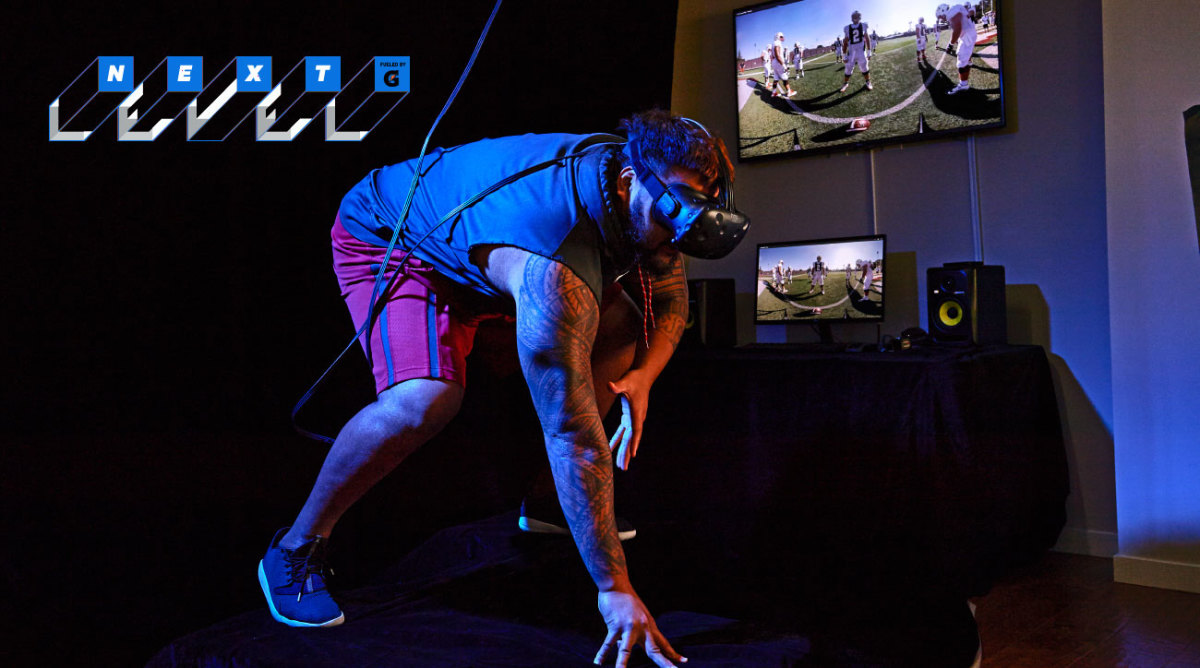
Go back to 1985, the year the first leaguewide scouting camp was held in Tempe, Ariz. No one outside computer labs or the military industrial complex had ever heard of the Internet. Personal computers ran off cassette tapes or floppy discs; cellphones weighed close to two pounds, cost $4,000 and stored 30 numbers. Even the game of football was different: There were no Jaguars, Panthers, Ravens or Texans; there was no first-and-10 line projected on TV broadcasts. Tablets and social media were nonexistent.
In this world, the first combine made a whole lot of sense. Previously, teams had evaluated talent by scheduling visits with players and running them through drills, or they relied upon a host of small camps that provided data only to those teams that subscribed. In 1982, a new event, the National Invitational Camp, was launched in Tampa. And by ’85 the smaller camps had combined with NIC. All 28 teams signed on, marking the start of the combine, which moved permanently to Indy in ’87.
The standardized testing used at that first combine—40-yard dash, bench press, vertical jump, broad jump, three-cone drill and shuttle runs—might well have been the best means at the time of quickly and objectively evaluating several hundred players and correcting for the inherent imbalances of college football. Stripping them of their helmets and shoulder pads, into their underwear, provided a side-by-side comparison (even down to their hand sizes); subjecting them to a cognitive-ability test—the Wonderlic—gave NFL execs a glimpse inside. But the idea that they could line up prospects and, with a stopwatch and cones and an exam, sort out the future Pro Bowlers with relative success? That was never going to be perfect. For proof, just type out “NFL draft busts” and watch your search engine explode.
Inside the wearable tech backed by the 49ers that could change the NFL weight room
“Coaches have egos,” says Kevin Kelley, the Pulaski Academy High (Little Rock) coach who has won six state titles using unconventional tactics, such as never punting. “They think that if you get ’em a guy who runs really fast and jumps really high, they can make him into a player.”
And that’s just not true. “There is no relationship or association between how many times a guy can bench-press 225 pounds and how well he'll do in his NFL career,” says Roberts. Adds Dan Hatman, a former NFL scout who’s now the director of development for the Scouting Academy, “The best argument I’ve heard for the relevance [of the bench press] is [that it shows] work ethic in the weight room.” In fact, a 2008 study in The Journal of Strength & Conditioning Research found “no consistent statistical relationship between combine tests and professional football performance, with the notable exception of sprint tests [e.g., the 40] for running backs.” Another study, published in ’11 by the journal Human Performance, found that “an indicator of past performance [such as success in college] engendered a stronger relationship with future NFL performance than a variety of physical-ability tests administered during the NFL combine.”
Before They Were Pros: Future NFL Players at the Combine
QB Vinny Testaverde, 1987
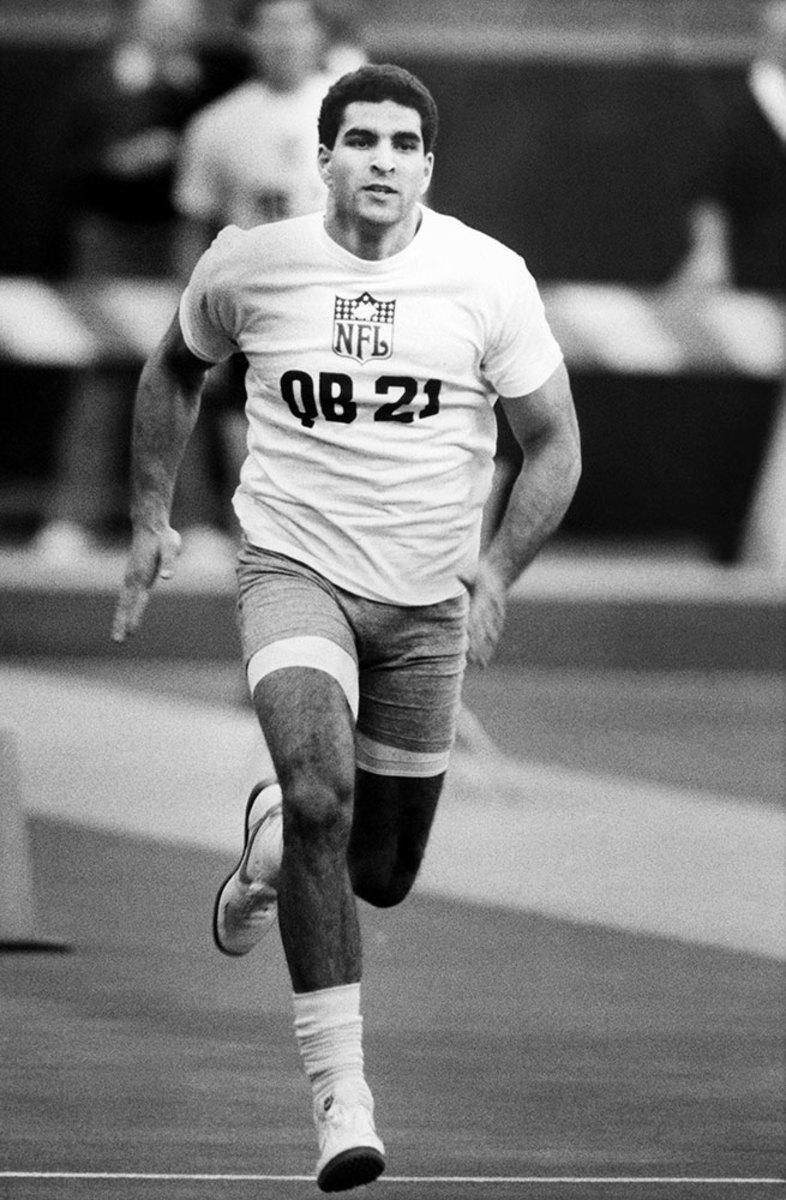
DB Rod Woodson, 1987
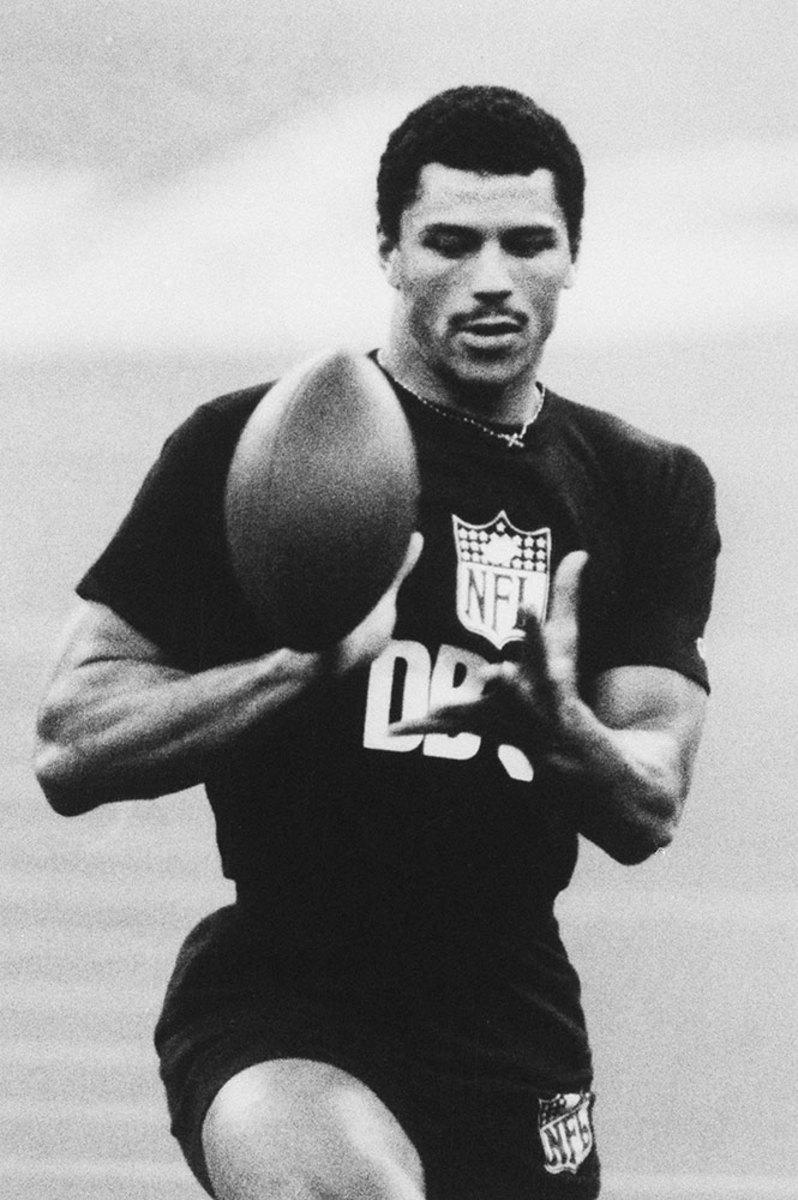
QB Steve McNair, 1995
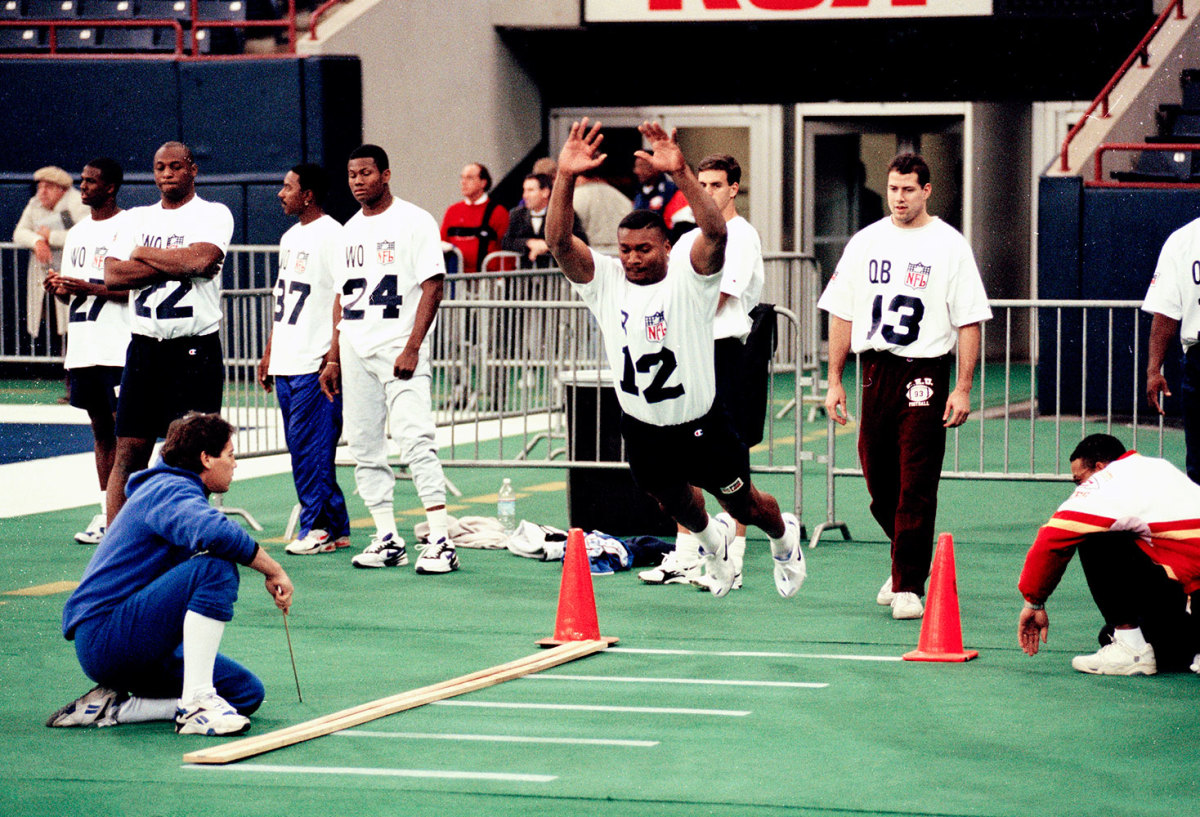
RB Ahman Green, 1998
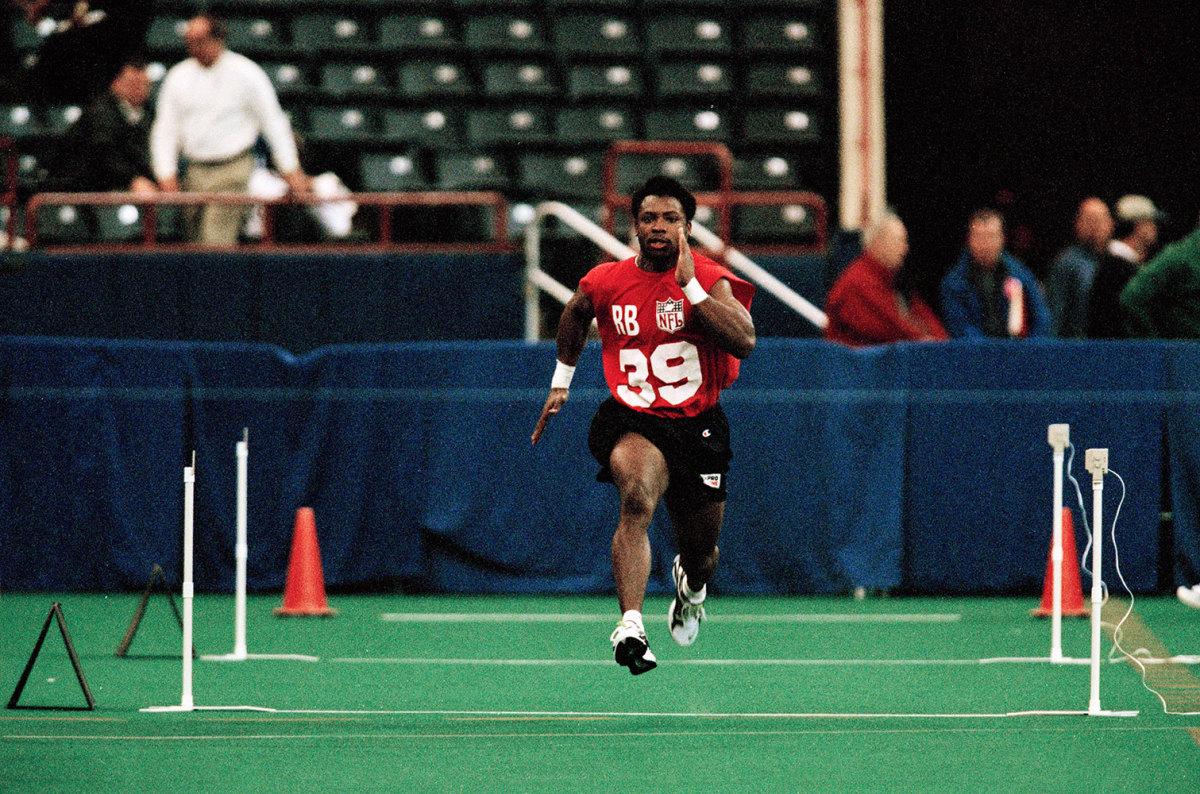
CB Jerry Azumah, 1999
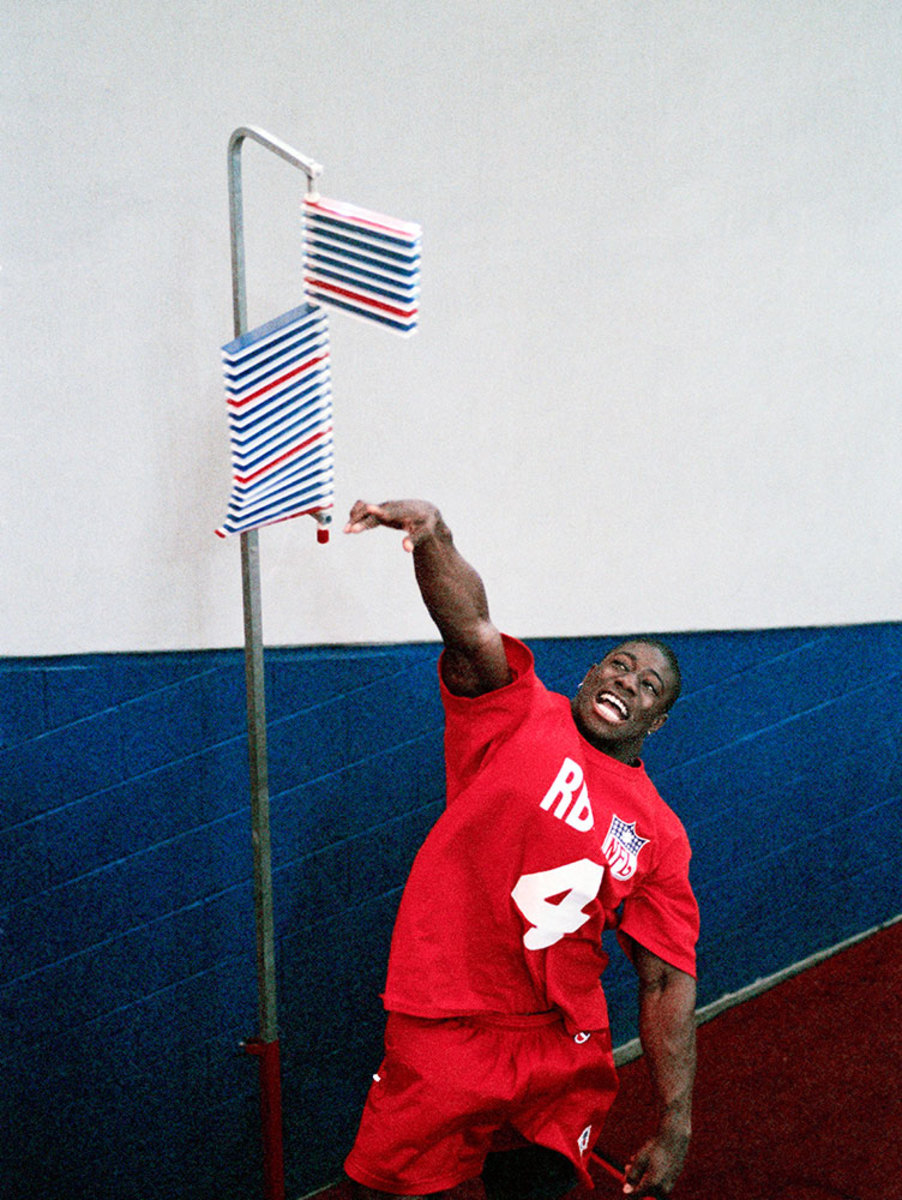
RB Reuben Droughns, 2000
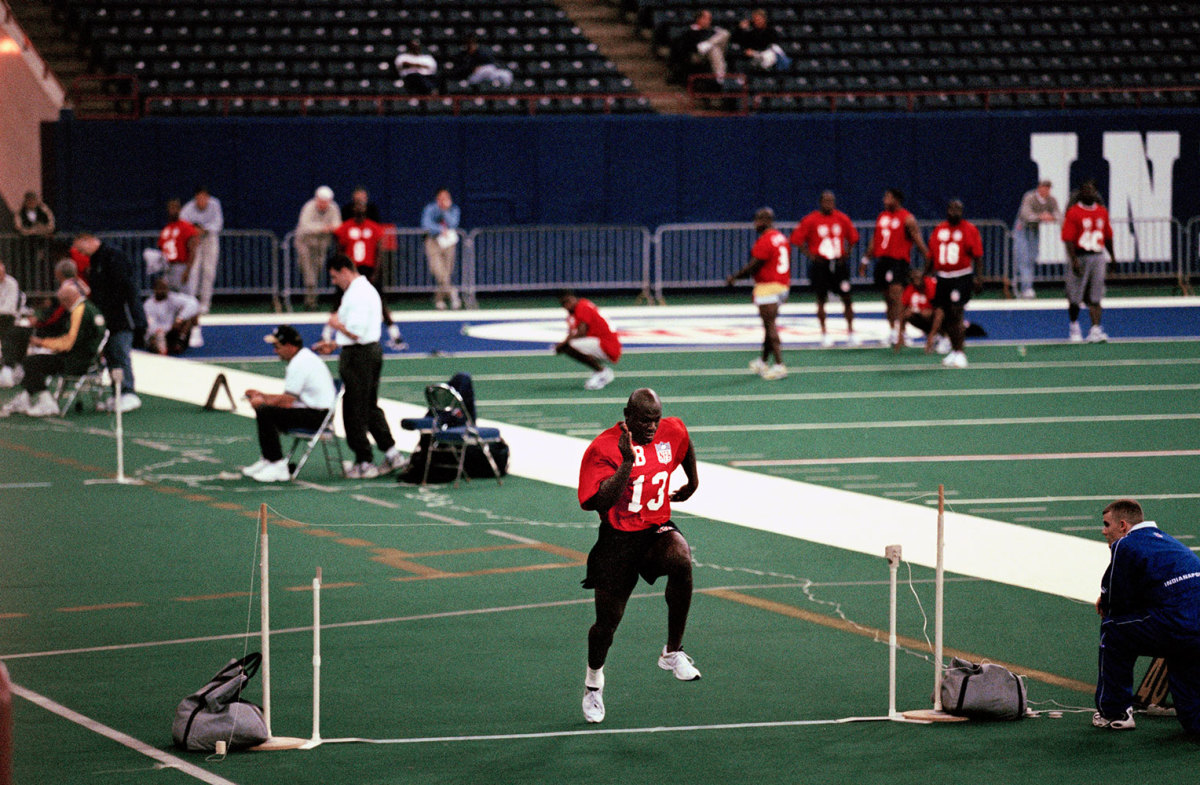
QB Drew Brees, 2001
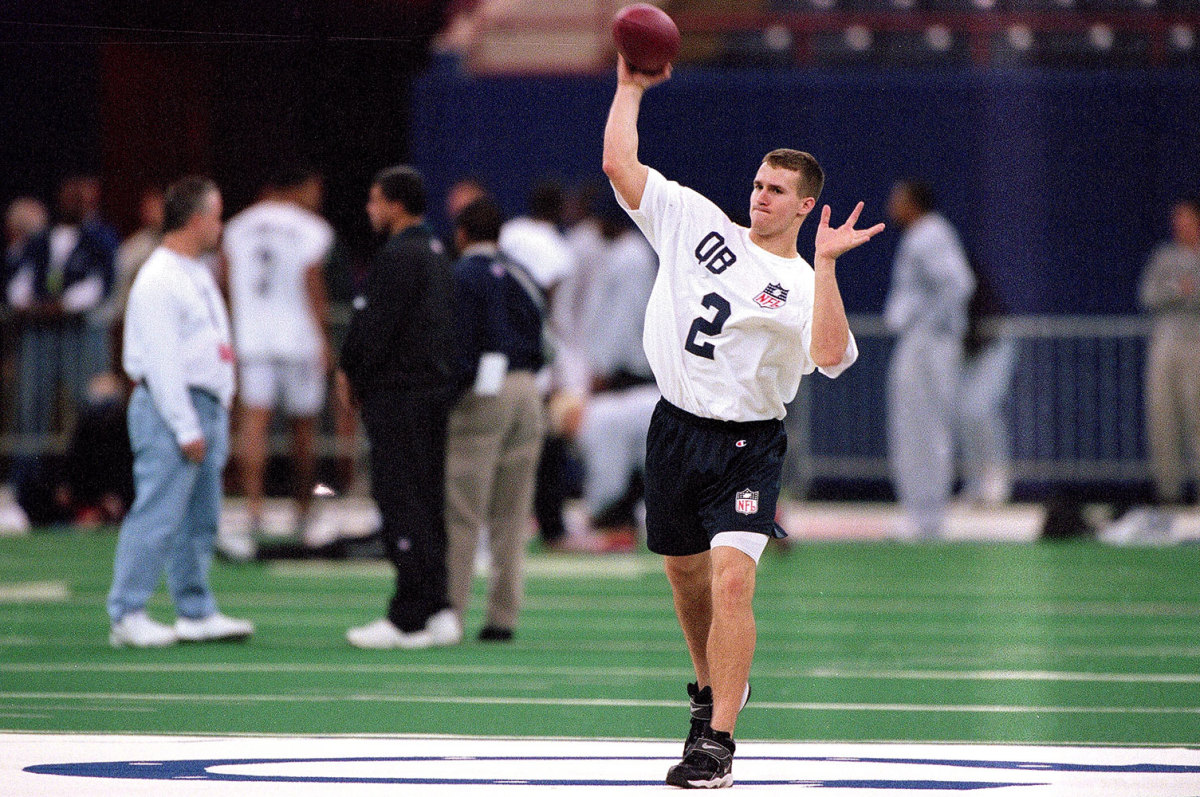
QB Chris Simms, 2003
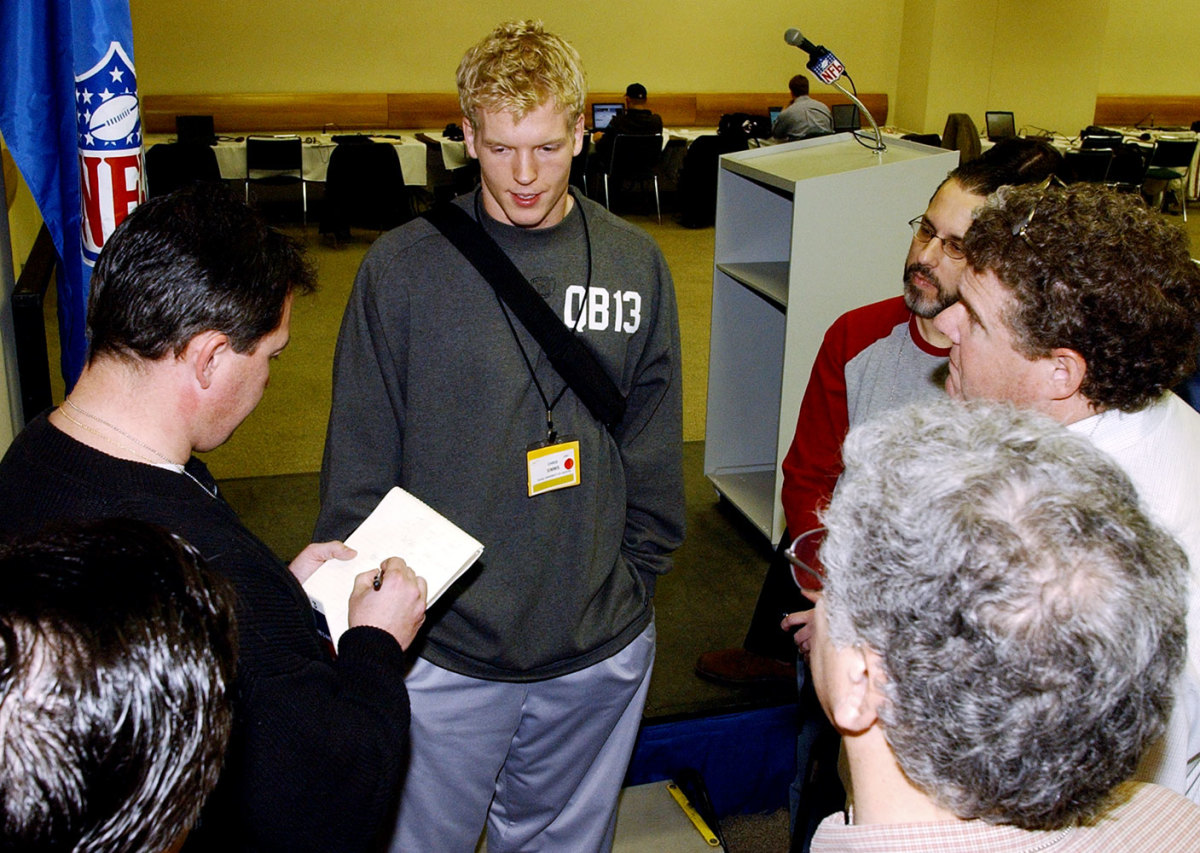
WR Lee Evans, 2004
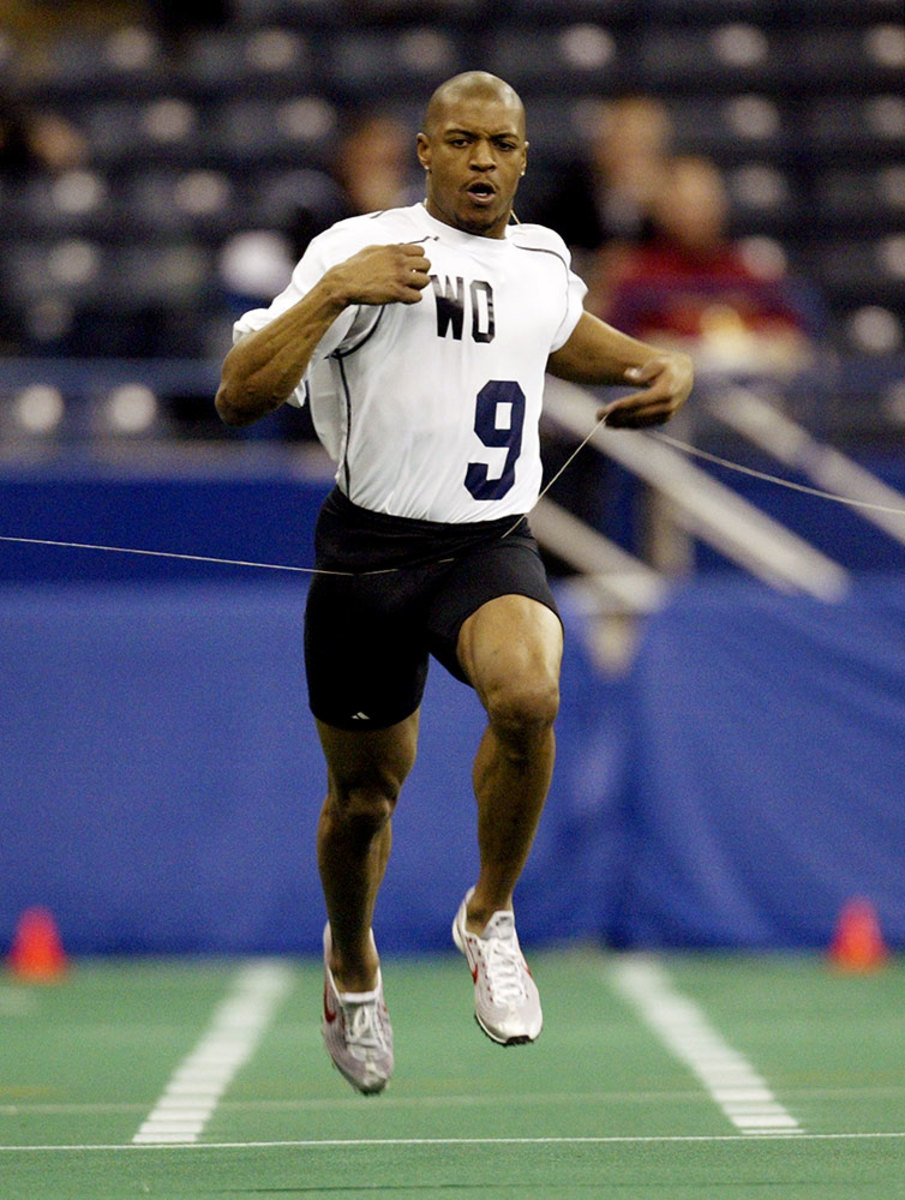
RB Ronnie Brown, 2005
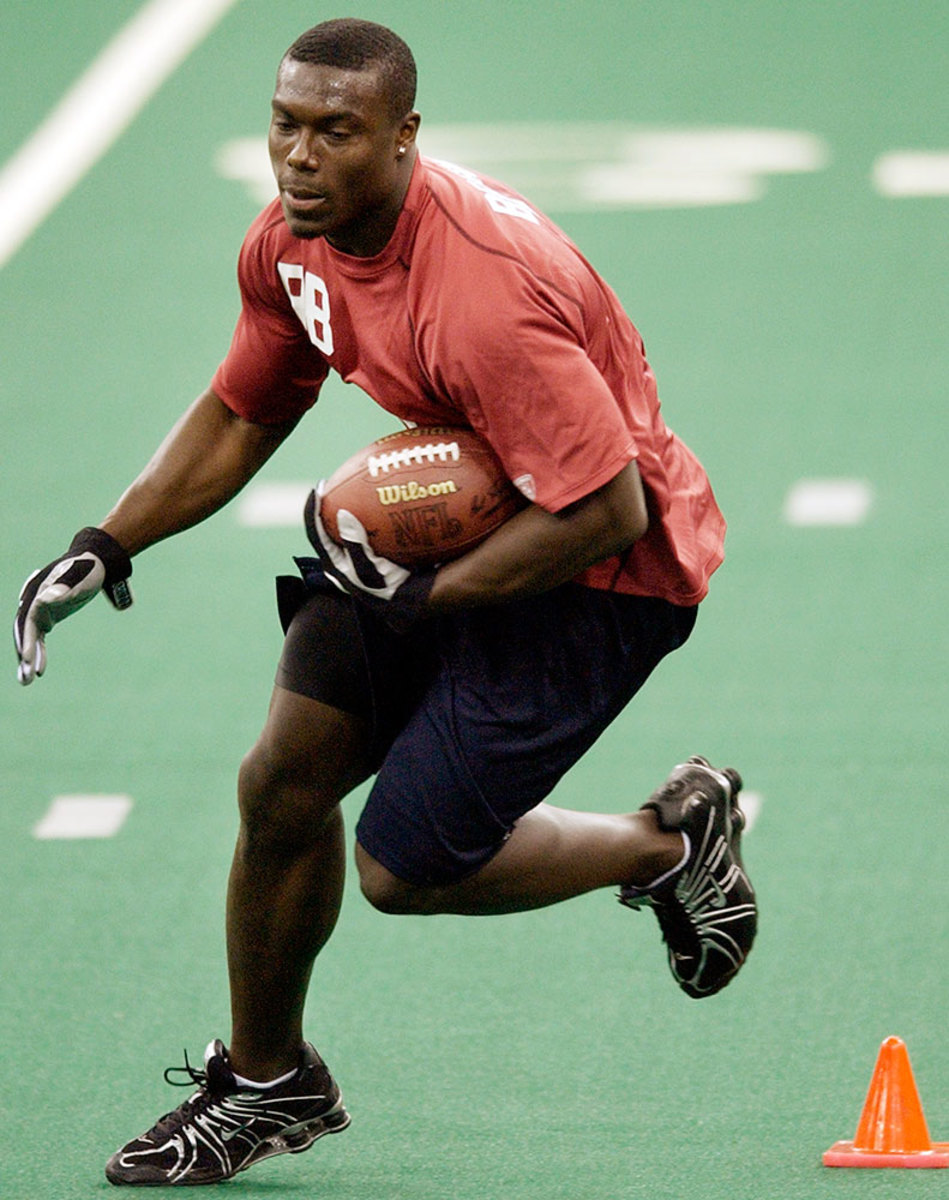
DE Mathias Kiwanuka, 2006

TE Greg Olsen, 2007
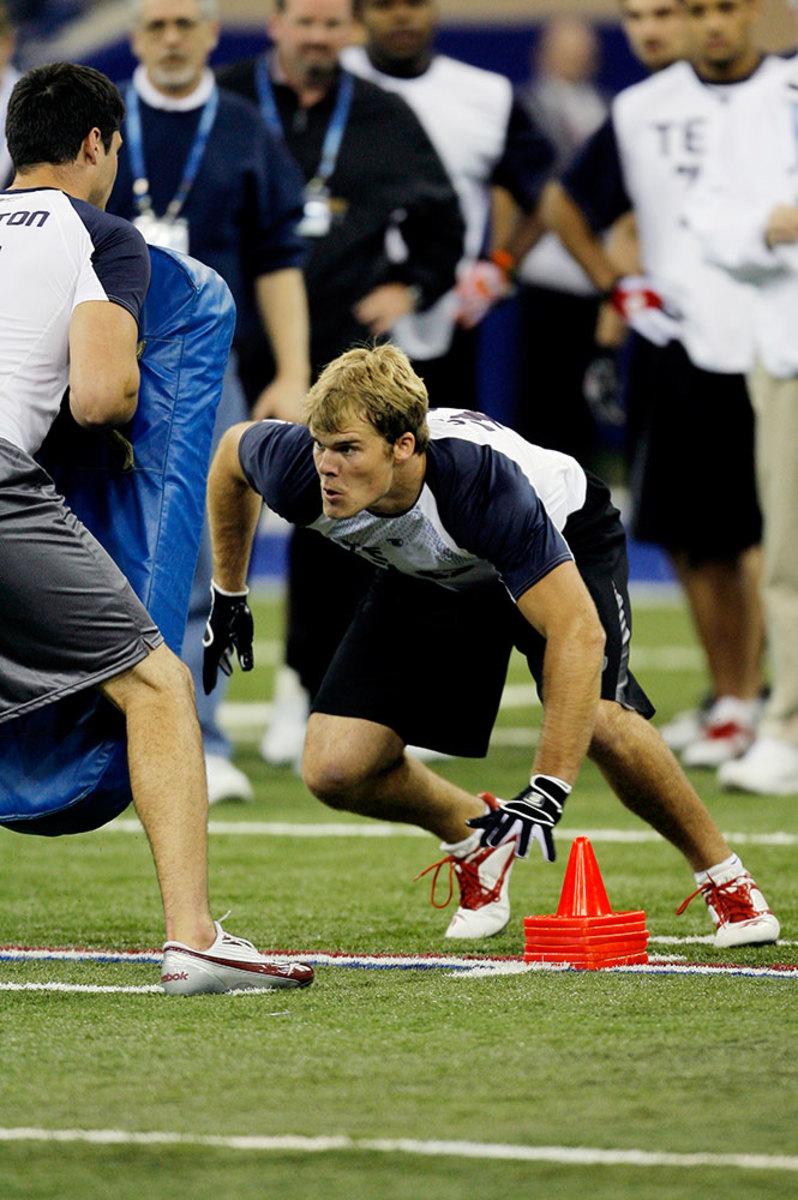
RB Tashard Choice, 2008
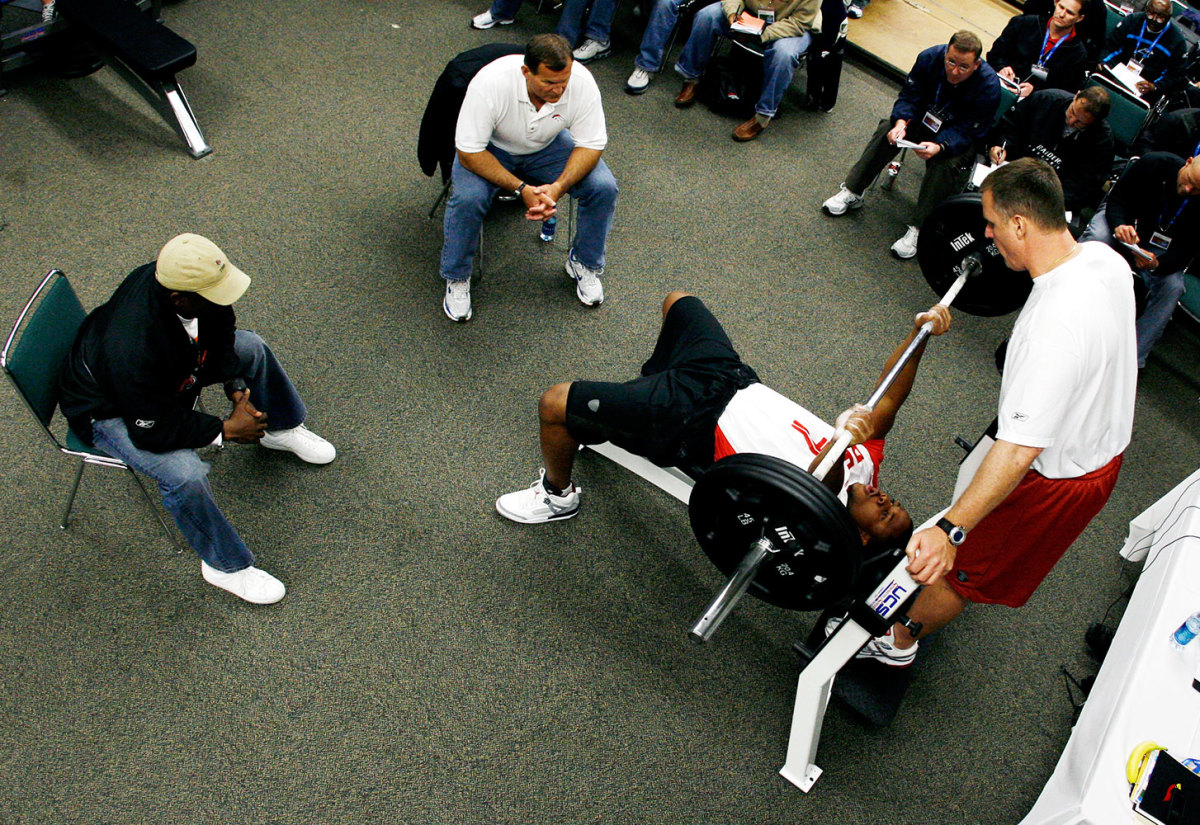
WR Kenny Britt, 2009
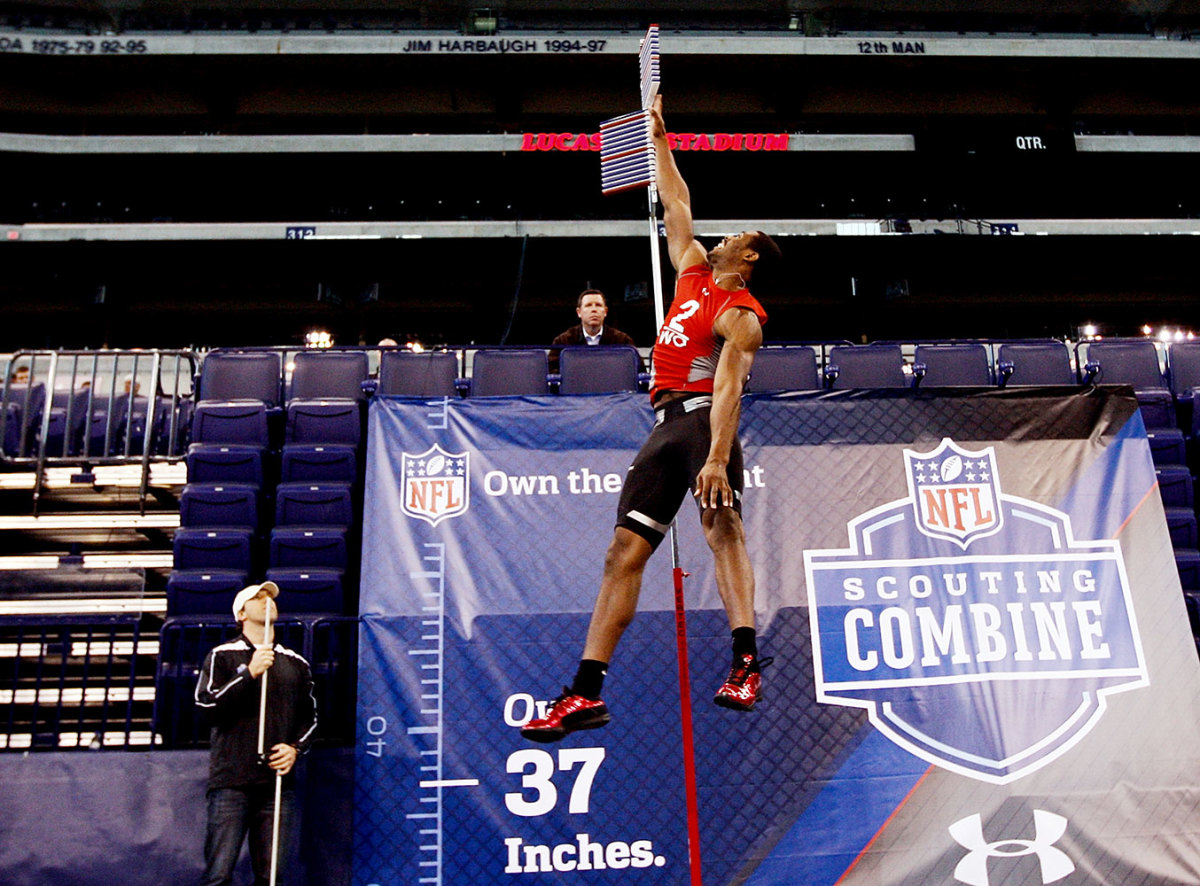
QB Tim Tebow, 2010
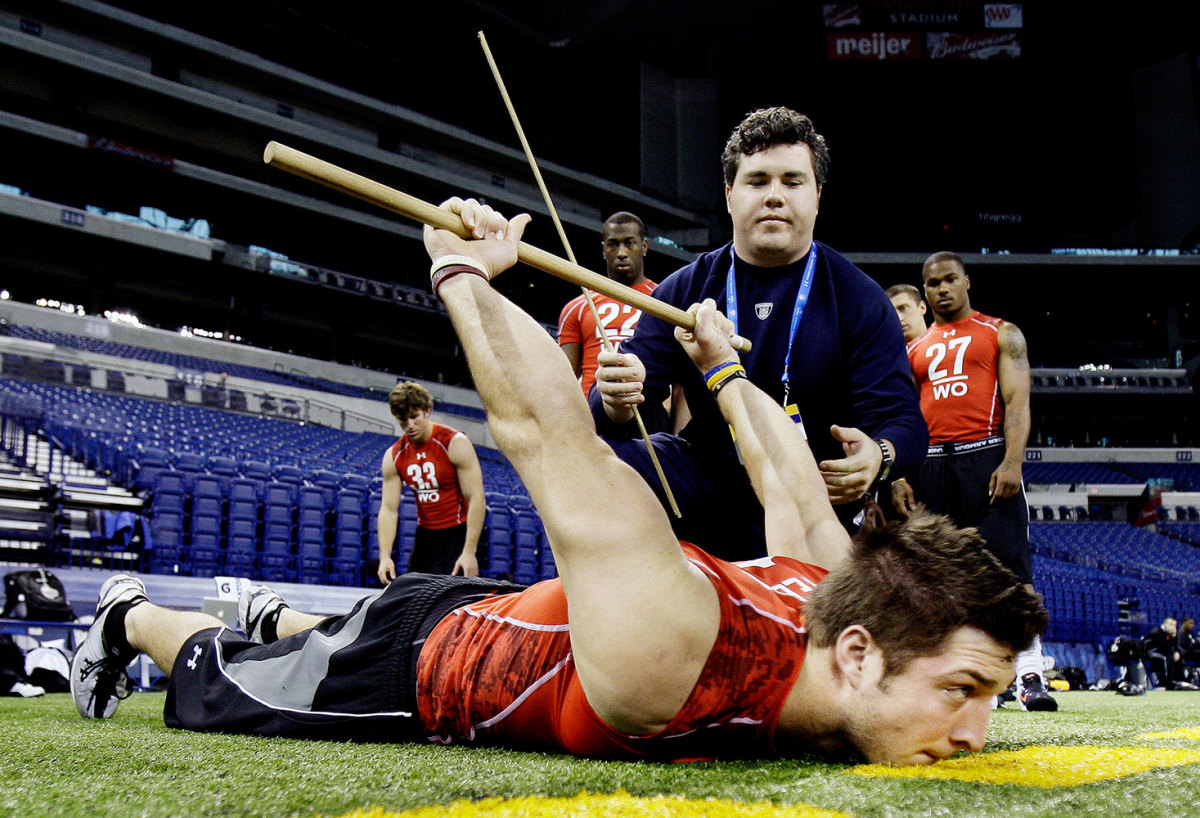
DE J.J. Watt, 2011
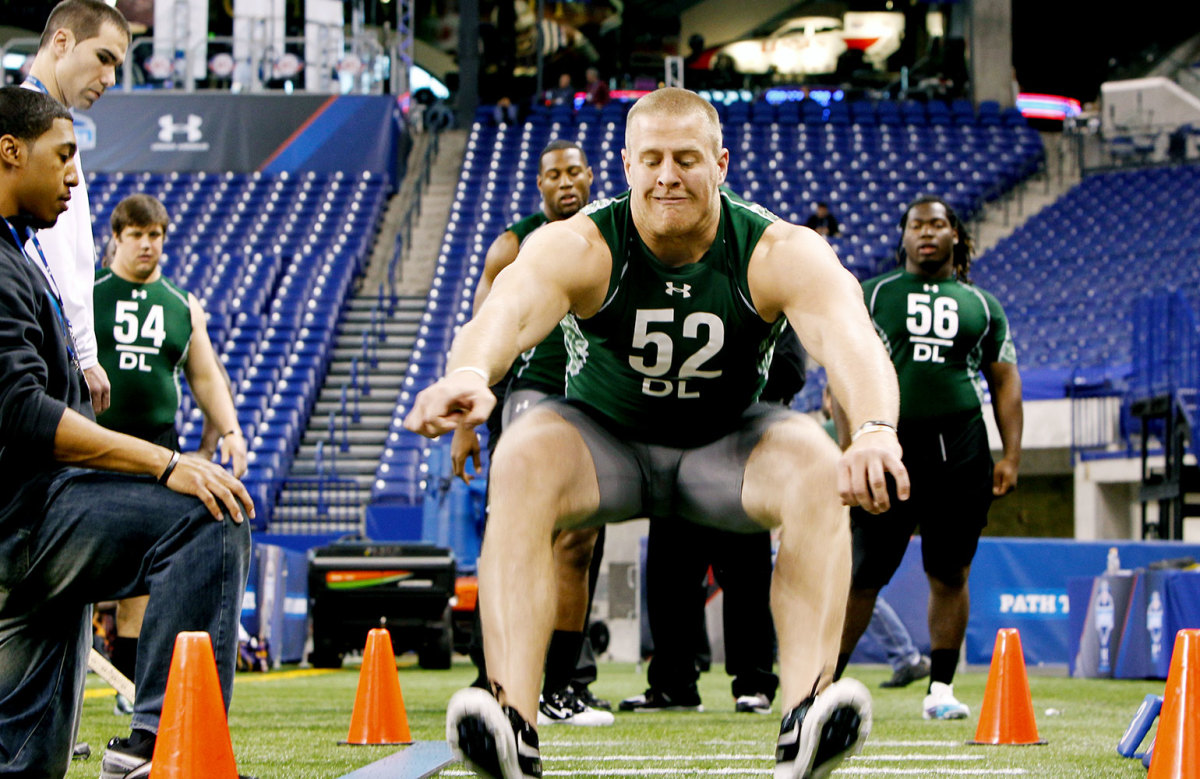
QB Andrew Luck, 2012
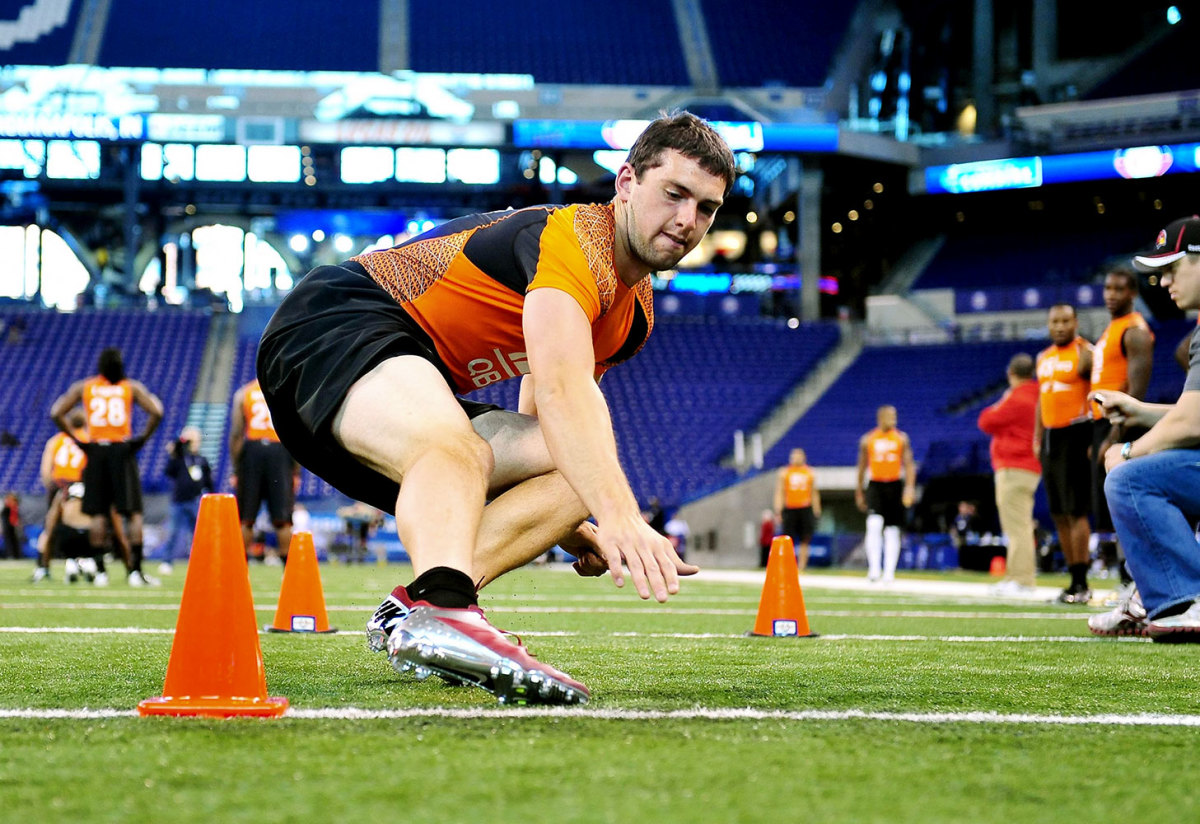
CB Tyrann Mathieu, 2013
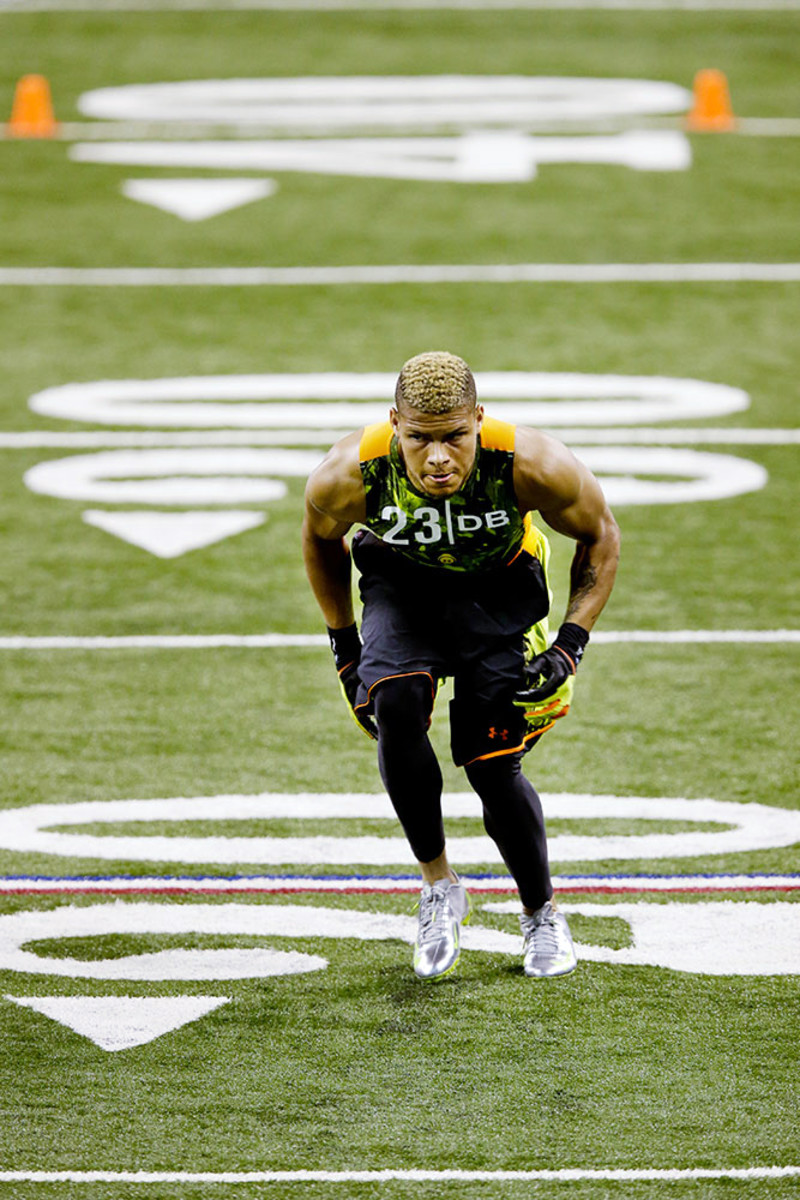
WR Odell Beckham Jr., 2014
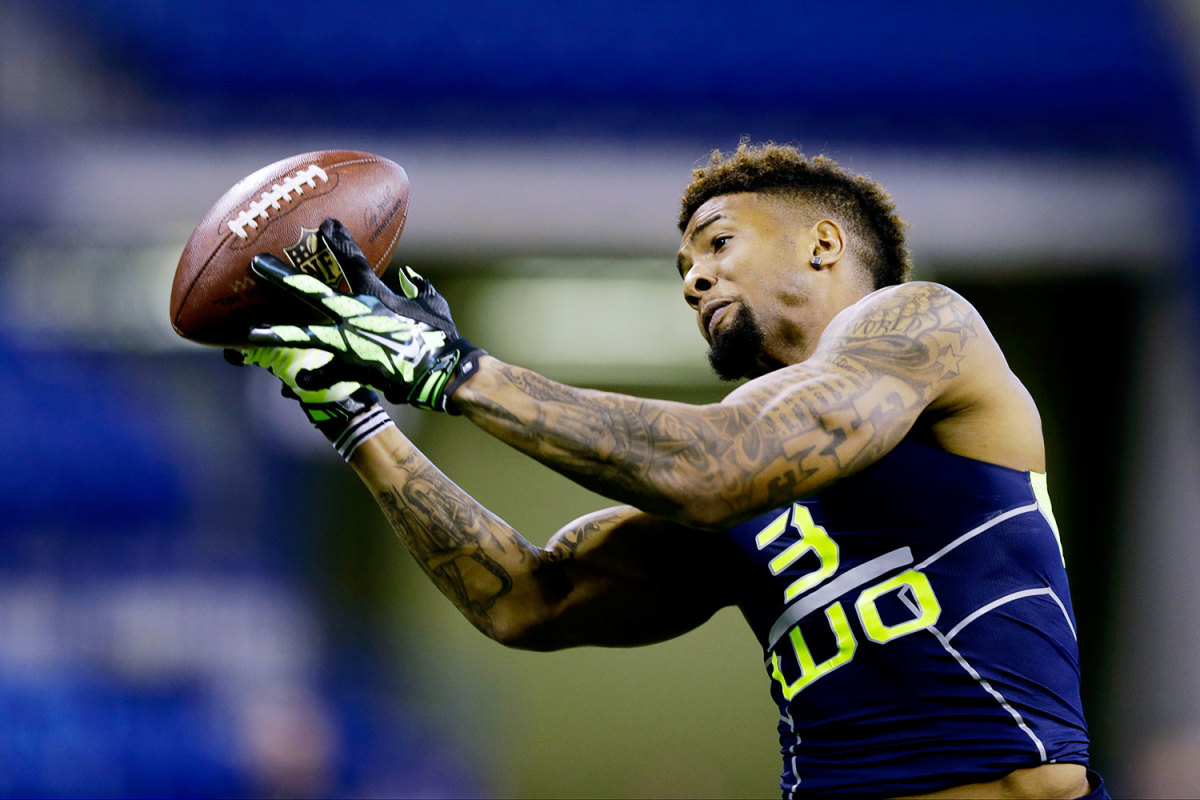
DT Leonard Williams, 2015
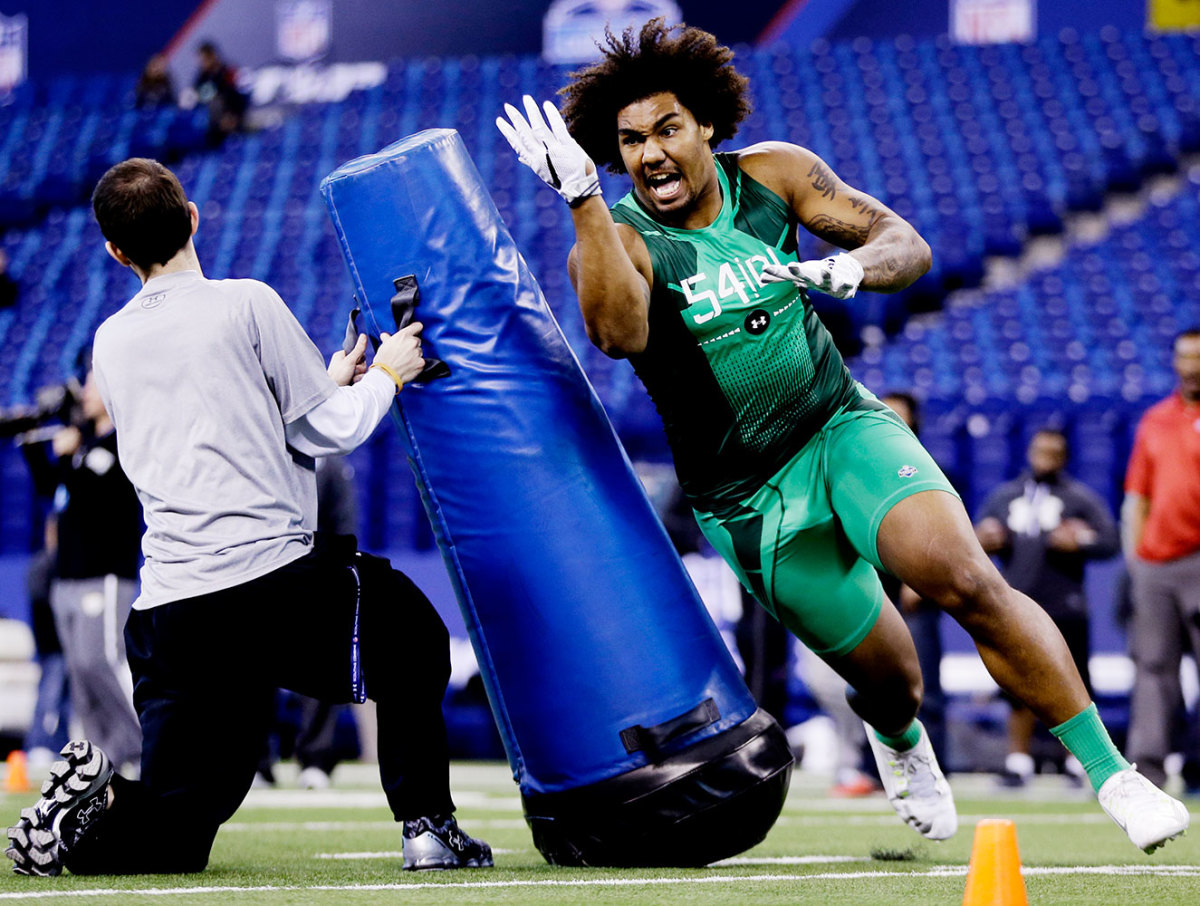
QB Dak Prescott, 2016
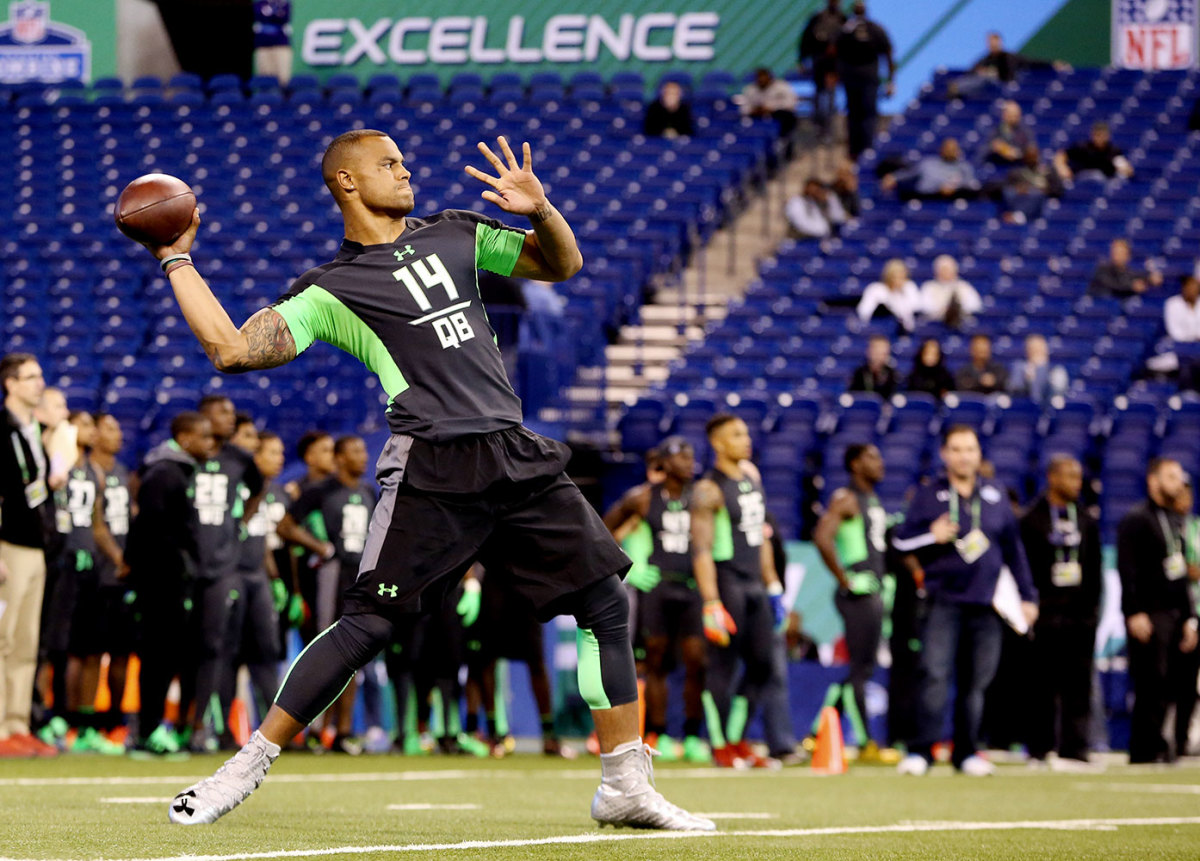
Pretend for a second that there is a correlation, that A-level skills-test results are largely predictive of A-level pro performance. Even then there are shortcomings in today's combine. UCLA quarterback Steve Bono recalls working out at the first combine: “Three hundred guys standing out there in their underwear onstage, and everybody’s staring at you.” By his recollection, training for the drills just wasn't done then—which, really, was a fairer setup for everyone. Today’s prospects know exactly what’s on the exam ahead of time, and an entire cottage industry has been built around helping them rehearse their answers over and over again.
One way to change that: a dose of random variation. In the combine’s three-cone drill, markers are placed five yards apart in an L shape and players run around them in a predetermined route; in the short shuttle, they run back and forth, always in the same order, between two sets of cones spaced five yards to the left and right of a starting line. Clocking the fastest time is as much about mastering a very specific sequence of steps as it is about foot speed. Says Marcus Elliott, who founded the Peak Performance Project training center in Santa Barbara, Calif., and who spoke at the NFL's first football performance and technology symposium at last year’s combine: “You can have a great [drill] mover who in a reactive environment is a really mediocre mover.”
Add some intelligence to your workout with these NFL Combine-inspired wearables
That type of thinking led SI to a cavernous training center in Menlo Park, Calif., where on a rainy Thursday night in February, two Intel techs spent several hours unspooling thick blue Ethernet cables and setting up tripods around a rectangular swath of artificial turf dotted with low white cones. “This is a riff on the original cone drills,” explained Jimmy Hall, an Intel research scientist who had answered SI’s challenge to tweak the combine using technology. “Instead of saying, ‘O.K., you’re going to run exactly this course,’ you [have athletes] learn what course they’re going to do as the drill goes on.”
To demonstrate his drill Hall used two NFL prospects who are prepping for the draft with Sparta Science, an athletic performance training center and software company: Kiola Mahoni, a guard for two seasons at Louisville, and Robert Barber, a four-year contributor at defensive tackle for Washington State. (Neither was invited to Indianapolis, but each will run through similar workouts at his school’s pro day.)
Hall’s drill was a simple test of reaction at speed. Eight cones—each containing LEDs that could be illuminated by remote—were set up in a Y shape: two at the bottom of the Y, two at the center axis and two at the end of each prong. In cleats affixed with special tracking tags able to communicate with the ultrawideband radio receivers mounted on the tripods, Mahoni lined up between the two cones at the bottom of the Y. Five yards ahead of him was another pair of cones; and five yards farther, 45 degrees to the left and right, were two more sets, marking two possible finish lines.
In essence, Hall’s drill mirrored the challenge a running back might face heading toward the line of scrimmage and hitting whichever hole opens up. When the middle cones flashed blue—Go!—Mahoni launched off the start line; as he crossed between the blue midpoint cones, the finish-line cones to the left turned red and so he swerved in that direction. California’s rainy season had forced the drill inside, and Mahoni narrowly missed taking out Hall and his laptop computer in the cramped space near the finish.
Mahoni and Barber ran the new drill several times, trying not only to get the quickest time but also to work out the best tactics. Reaching the blue-cone decision point at too much speed hindered their ability to change direction toward the correct finish line, and trying to predict which way to run proved too risky, not unlike an actual football situation. “If you guess wrong,” said Mahoni, “you’re basically done.”
As engineers, Hall and his team focused on applying technology rather than entirely reworking the mechanics of a new drill; what they demonstrated was a simple setup that could be easily altered. Intel's cones can be laid out in any formation and programmed to light up—red, white, green or blue—in any sequence. And Zebra MotionWorks has already installed similar ultrawideband tracking technology at every NFL stadium (though that system tracks players using tags in their shoulder pads instead of on their cleats). In other words: It wouldn’t be difficult to introduce a tech-aided combine test that better evaluates both movement and reaction.
“You should know what you’re gonna do if you’ve been working on [the cone drills at today’s combine]. It's like muscle memory,” says Mahoni, adding that with Hall’s drill, “you’ve got to react. Just like on the field.”
Which brings us back to a central problem: The combine isn't really a test of football skill; it’s a test of who is best at the combine. “With what we know about skills and learning, what really determines how well people perform is their performance on task,” says Stephanie Wander, a senior manager at XPRIZE, a foundation that oversees technology-based competitions aimed at benefiting humankind. (The most famous of these challenges helped launch private space flights in 2004.) “And so you want to test things that are as close to what they’re actually doing as possible. We know how good a driver you are because you drive,” Wander says, “not because you take a [written] driver’s test.”
The combine’s version of the written driver’s test is the Wonderlic (and to a lesser extent the Player Assessment Tool, added in 2013 to analyze football-relevant personality traits). The Wonderlic is flawed not only in its cultural bias but also because any athlete can boost performance through studying, which has no correlation to football IQ. Mike Mamula famously tops the table of reported combine Wonderlic scores, with 49 out of 50 in 1995. Alas, little about his five years in the NFL suggests that that success translated to the field. (Then there’s Colts running back Frank Gore, who reportedly scored a six and is likely to be inducted into the Hall of Fame.)
A truer means of objectively measuring football IQ might involve using virtual reality. Since 2015, STRIVR, another Menlo Park–based tech firm (which counts among its clients the 49ers, Cardinals, Cowboys and Vikings, as well as an array of college teams, including Clemson), has been helping players get extra mental reps through plays recorded on VR cameras, essentially placing them at the line of scrimmage or in the backfield. Within the last year STRIVR has begun developing that training tool into an assessment tool, focusing initially on key decision-making positions. Quarterbacks are shown a series of plays from the pocket and then asked to identify the coverage schemes; linebackers view the line of scrimmage at the snap, then have four choices for which direction to pursue—far left, left, right or far right. Players are graded on whether they make the right call and how long their decision takes.
Prospects in Indy, meanwhile, often scribble down X’s and O’s on a whiteboard during their interviews. With VR, says Derek Belch, the founder and CEO of STRIVR, “you can put [a prospect] into your system before drafting him to get a good sense ‘O.K., this guy gets it—or this guy doesn’t get it, this is how we could develop him.’”
At Menlo Park, Barber put on a STRIVR VR headset and was immediately transported to the line of scrimmage of an outdoor practice field in South Carolina, where he stared down Clemson’s offensive line. He dropped into a three-point stance and, as the ball was snapped, instinctively launched his body across a tiny office space. His training buddy, Mahoni, caught him before he crashed into a desk.
“This feels more like football [than studying a whiteboard],” Barber said. “I can handle the physical [element of the game], but to me it’s also mental.” In the VR world he found himself recognizing plays and hedging his movements based on things like the motion of the center and the direction of players’ eyes.
Both STRIVR and Intel already have partnerships within the NFL. With the right technology—VR headsets and smart cones are only the start—football’s key skills could be distilled into new drills that would advance the combine into the 21st century. Perhaps those tests would even be adapted by NFL coaches, giving them a way to train and evaluate players long after they've graduated to the league.
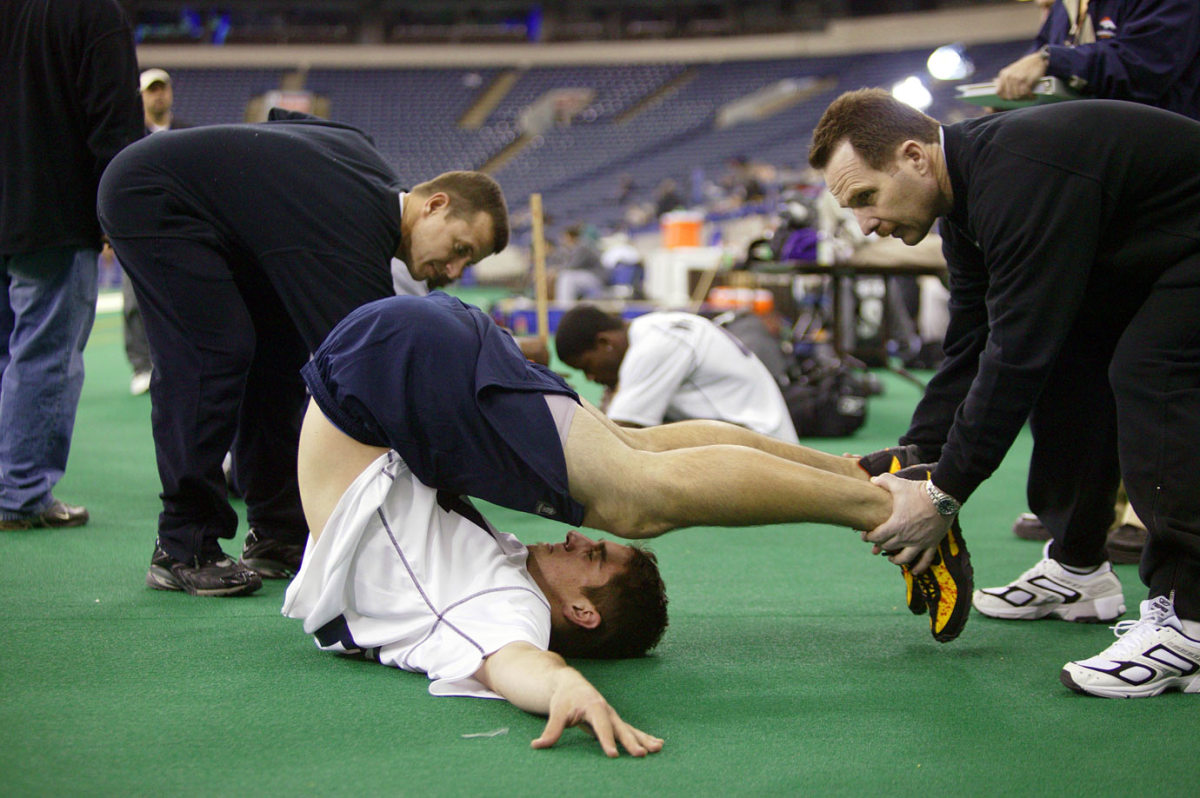
The biggest obstacle in reinventing the combine might be, simply, tradition. “There are much more insightful ways to measure an athlete nowadays,” says Roberts, “but it all comes down to: Those tests are what coaches are familiar with.”
Lacking as they may be, the current drills still provide three decades’ worth of reference data. Coaches can look at Florida State cornerback Jalen Ramsey, from the 2016 combine, and make a comparison all the way back to another former Seminole, Deion Sanders, in 1989. The 6' 1", 195-pound Sanders ran a 4.27-second 40, was drafted No. 5 by the Falcons and went on to have a 14-year Hall of Fame career. The 6' 1", 209-pound Ramsey ran a 4.41—adjusting for weight he was actually a shade faster than Sanders—and was picked No. 5 by the Jaguars.
Keeping that advantage in mind, the easiest way to introduce new technology would be to integrate it into existing drills—that way, everyone is happy. Sparta’s training programs function with this in mind. When Mahoni and Barber began working out with the prep outfit in January, one of the first drills they did was the vertical leap. But in this version they leaped from a force plate—essentially a high-tech bathroom scale installed in the gym floor—that measures the ground reaction force of an athlete until his feet leave the force plate.
Standing on the flat gray rectangle at Menlo Park last month, Barber stretched his bulging arms above his head; his biceps, tattooed in Samoan art and the initials WSU, popped through a black sleeveless Cougs hoodie as he stared at the countdown clock in front of him. At zero he dropped into a crouch, swung his arms downward and exploded back up. Before he had even touched down, a screen flashed his jump height: 52 centimeters. Knowing his weight and the force he applied to the ground, Sparta could accurately predict how high his center of mass will move before gravity pulls him back down.
The combine's most disastrous 40-yard dash ever? A year ago, Chris Jones took it in stride
Barber jumped five more times, and Sparta averaged the best three to create a simple movement signature represented by three columns on a bar chart: load, explode and drive. (Load is the average rate of force change through the plate as the athlete crouches and prepares to jump; explode is the rate of force change as he begins to move upward; and drive is the total upward impulse—force multiplied by time—he obtains before his feet leave the plate.) Instead of raw measurements, the columns are scaled so the players can be compared against others in Sparta’s database.
According to Sparta, the desired combination of scores will vary depending on a player's football position, though if any of the bars is significantly different in height from the others, it may indicate an imbalance that could lead to injury. (Or, says Bryce Patterson, a Sparta coach, "People who have imbalances can be special—we've just got to make sure they're in whack.") Linear athletes, such as receivers, are expected to have bars that increase in height from load to explode to drive. Rotational athletes, such as quarterbacks, typically have lower explode bars than either of the other two metrics. And lateral athletes, like running backs, have a higher explode bar. After Mahoni took his initial test, in January, trainers determined that his load phase was low relative to his explode and drive, so squats were added to his workout routine. Barber’s load was fine, so he wasn’t assigned squats.
Three years ago Sparta partnered with the Falcons to develop a draft evaluation program built around its force-plate test, and Sparta’s database now includes scans of 800 NFL players. The test would be fairly easy to append to the combine, with athletes performing their verticals from force plates. Teams would gain an understanding of not just how high each one jumps but also how they jump that high. And traditionalists would still have access to the old jump metric.
Of course, this all assumes that keeping the old data as a comp is even useful. “Places like [Sparta and EXOS, a similar company based out of Phoenix] have drastically changed the training in such a way that comparing a test score from 10, 15 years ago to today is not apples-to-apples, in my opinion,” says Hatman.
“If the historical data doesn't mean anything,” asks Elliott, “who needs context?”
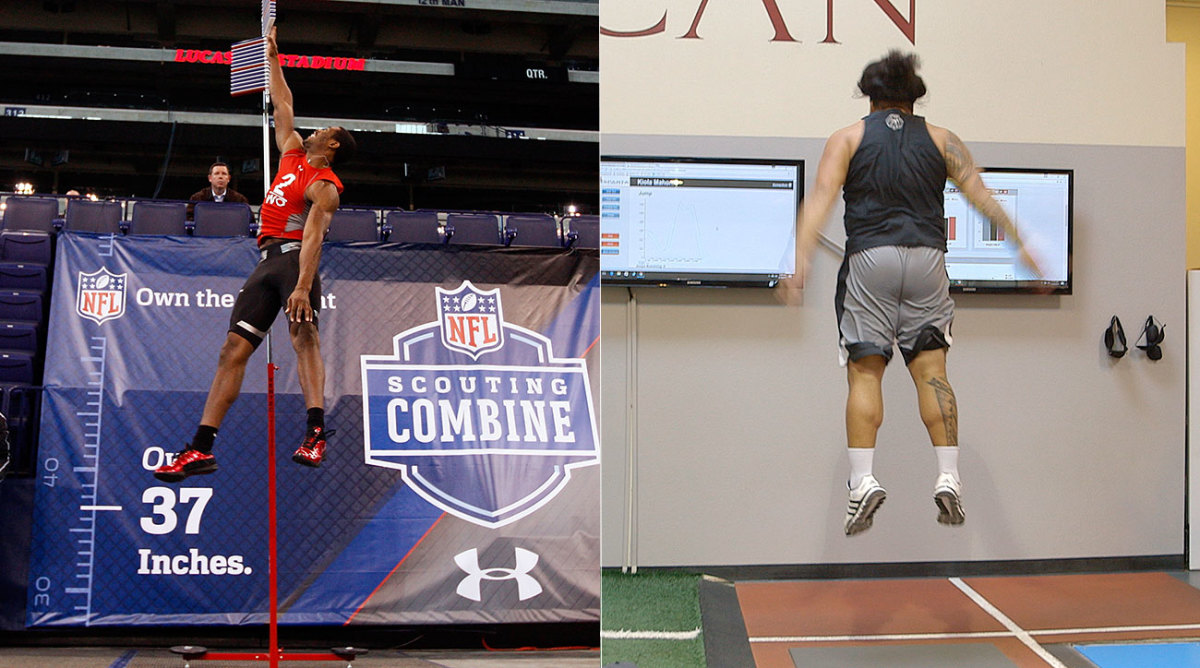
According to the league, this year’s NFL Fan Experience at the combine will give football enthusiasts the chance to traverse an obstacle course (Race through agility drills, just like the prospects!) as well as something called “the Gauntlet” (Run a straight route towards the end zone, catching balls from JUGS machines on your left and right, and dive into the end zone!)—a sort of football-themed American Ninja Warrior. In reality, neither of those attractions mimics the actual combine drills, but those days may not be terribly far away.
Taking STRIVR’s virtual-reality drills, for example, any fan with a VR headset could in theory run through the same test that prospects would take. If other physical tests could be wrapped around popular wearable technology, like Fitbits or Apple Watches, millions could log in and play along too. In the age of Big Data, an online combine might even unearth an occasional NFL contributor among the thousands of college players who aren’t invited to Indy.
And ultimately that’s the goal: to identify players. In 2000, Tom Brady entered the draft having set Michigan passing records while winning both the Citrus and Orange Bowls. But the combine completely failed to spot his potential. He ran the 281st-fastest 40 time, the 100th-fastest three-cone drill and the 107th-fastest shuttle run, and logged the 225th-highest vertical and 206th-longest broad jump. Today he's arguably the best NFL player ever. You could also say, though, that the Patriots’ taking him in the sixth round was the greatest bargain in NFL history.
So consider: A better combine might level the information playing field, and that might have unintended consequences. “We’re all trying to rob the same train,” says Geep Chryst, a former offensive coordinator for the 49ers who now coaches tight ends for the Broncos.
The smartest teams might not actually want a smart combine.
